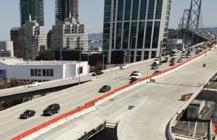San Francisco officials are watching closely to see if higher tolls on the Bay Bridge might help the city make the case for charging fees to drive into downtown in high-traffice periods — and so far, the evidence is promising.
Since tolls increased July 1, an additional 4,000 commuters turning to BART — and that means fewer cars on the bridge.
The Bay Area Toll Authority elevated fees during the hours of 5 am to 10 am and 3 pm until 7 pm for crossing all bridges except the Golden Gate, which is managed by a different agency.
Drivers crossing the Bay Bridge during weekday commute hours are now expected to pay $6. During other hours, the weekday toll remains at $4. The toll is $5 on both Saturday and Sunday.
The toll has also been bumped up to $5 on the Antioch, Carquinez, Dumbarton, San Mateo, Benicia-Martinez and Richmond bridges. Although previously exempt from charges, occupants in the carpool lane now pay $2.50.
These increased costs may have prompted discontented commuters to add to the approximately 335,000 individuals that use BART each day, spokesman Jim Allison said.
“We have seen 2,000 to 4,000 more people riding BART on an average weekday this month compared with last,” he said.
Allison was careful to note that because of the brief time element and other seasonal changes, it is hard to determine higher tolls as the only reason for a boost in ridership.
“It is just too soon to draw any conclusions,” he said. “While it may be a factor, the increase cannot necessarily be attributed to the changes on the Bay Bridge.”
However, executives from the San Francisco County Transportation Authority planning to bring a citywide congestion pricing plan before the Board of Supervisors this fall were encouraged by the trend toward public transit.
“We do think that it is too early to draw any conclusions,” SFCTA deputy director for planning Tilly Chang said. “But the general indication is that people are shifting their behavior in some way, which is the goal of congestion pricing.”
The toll hikes mark the Bay Area’s first quasi-attempt at congestion pricing, with officials hoping to encourage the use of public transportation while simultaneously decreasing travel time for those who choose to stay in the driver’s seat.
According to a preliminary study on the compounded tolls, there were more than 12,000 fewer carpoolers and 2,300 more drivers paying the full fare on their commutes.
Spokesman John Goodwin said that the increase in solo drivers could be due to the new system’s ability to weed out cheaters, with FasTrak identification and a guaranteed minimum toll putting a damper on disobedience.
“It may very well be that we didn’t have as many real carpoolers as we thought we did,” Goodwin said. “There is, of course, no way of quantifying exactly how many drivers who didn’t meet the occupancy requirement are now recalibrating

